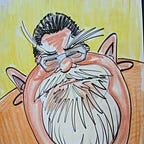Oswald and Al
Turner Classic Movies is running one of its periodic “Treasures From The Disney Vault” nights tonight, and seeing an old Mickey Mouse cartoon had me thinking about Oswald the Rabbit. I wrote a post on my old blog about the Oswald the Rabbit story, which I find fascinating and wonderful, but since my old blog posts went away I think I’m going to repeat myself here, something I’m never averse to doing.
The tale of Oswald the Rabbit is a tale of treachery and loss, long-awaited justice … and sportscaster Al Michaels.
No, really; bear with me.
Walt Disney had his first success as an animator with a live-action character named Alice, who interacted with an animated background. But in 1927, the Alice series had run its course and so Disney and his lead animator Ub Iwerks created a new character, Oswald the Rabbit, and signed a contract with Universal Studios to produce Oswald cartoons for them.
But Disney was betrayed by Charles Mintz, the distributor who had originally negotiated his deal with Universal. Mintz hired away many of Disney’s employees and began producing the cartoons himself; eventually, Universal itself took the character in-house and began producing Oswald cartoons without using a contractor.
The story as I originally read it was that Disney, flush with the success of Oswald, had taken a European vacation, and while he was out of the country (in an age before satellites and smartphones) his employees were hired away, and he returned to find his studio all but empty. The current Wikipedia entry does not paint it that dramatically, however.
Disney decided to create a new character. To this day, there are debates about how much of this character was created by Disney and how much was created by Ub Iwerks (who had remained loyal to his boss). But in any case, the first version of the character looked, well, a lot like Oswald the Rabbit, except that he had round ears instead of floppy ones. His name, of course, was Mickey Mouse.
Walt swore that he’d control the rights to his company’s original characters from that point forward, and he worked with companies like United Artists and RKO that distributed independently-produced films until he eventually started his own distribution company, Buena Vista. The Disney legal team became known for its aggressive protection of Disney trademarks, characters and copyrights.
Universal continued to produce Oswald shorts for a while, but they couldn’t compete with the popularity of Mickey Mouse.
Now, we flash forward almost 80 years.
Robert Iger, when he became chairman of The Walt Disney Company, was at a reception where he had a conversation with Diane Disney Miller, Walt’s daughter. Disney is a publicly-traded company, and the family no longer has a controlling interest, but obviously the company values its relationship with the family and would like to keep them happy whenever it can. Iger asked Mrs. Miller if there was anything he could do for the family in his new role.
She told him that the loss of Oswald had always been one of her father’s greatest regrets, and she’d love to see the rights to the character back in the Disney Company’s hands, sort of as a tribute.
At about the same time, there was a proposal for a Disney-themed video game in which the creators wanted to include Oswald.
Meanwhile, the National Football League had decided to shift its broadcast strategy and make the Sunday night game, rather than the Monday night game, its premiere primetime showcase. NBC outbid the other networks for the rights to this new Sunday night package. Since it had been years since NBC had been in the NFL business, and since the crew of ABC’s Monday Night Football were the gold standard of NFL game coverage at the time, NBC decided not to reinvent the wheel and hired many of the producers of Monday Night Football away from ABC, along with popular color commentator John Madden.
However, it was initially announced that Al Michaels, who was still under contract to ABC, would remain there, and would continue to do play-by-play for Monday Night Football, which was moving to ESPN, a cable network owned by ABC.
Michaels, as he saw his co-workers and friends flocking to NBC, asked his representatives if anything could be done. The executives at NBC certainly wanted Al Michaels if they could get him, so negotiations started between NBC and ABC about what it would take to buy out the remaining years of Michaels’ contract.
By this time, NBC and Universal Studios had merged, and years earlier the Disney Company had purchased ABC. So Bob Iger, as head of ABC’s parent company, proposed a trade. I don’t know if any money changed hands, but in return for Al Michaels’ services, NBC/Universal agreed to give ESPN slightly better (but still restrictive) terms for showing Olympic highlights on SportsCenter, and they agreed to transfer the character rights to Oswald the Rabbit, as well as the rights to all of the Oswald films done by Disney, back to the Walt Disney Company.
So, to put it in the simplest terms, ABC/Disney and NBC/Universal traded Al Michaels for Oswald the Rabbit, like third-graders swapping baseball cards.
Universal still holds the rights to the Oswald films that were produced after the character was taken away from Disney. Some of those films involved Woody Woodpecker creator Walter Lantz and so have been packaged with “Woody Woodpecker and Friends” collections and the like. But the Oswald character itself and the original films now belong to the Walt Disney Company.
I just think that’s a fun story, although I sometimes wonder how Michaels felt about being traded for an animated rabbit.
